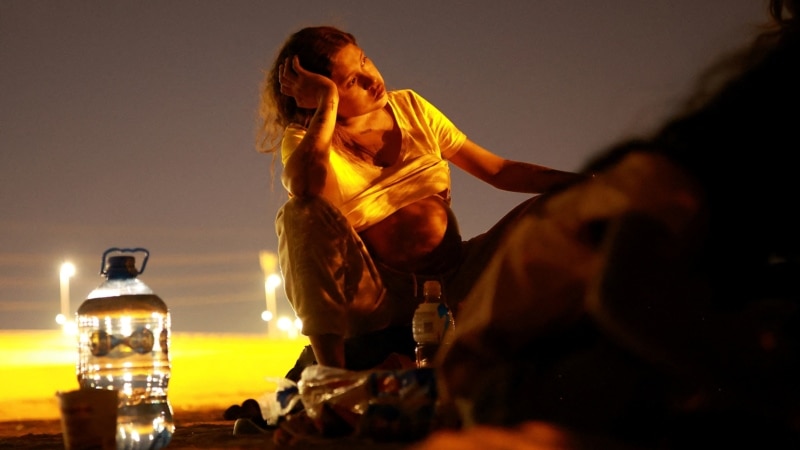More than a sixth of the total number of forcibly displaced people in the world are in Latin America, a truly worrying factor, indicated the UN Refugee Agency UNHCR, regarding the World Refugee Day which is commemorated this Thursday.
Recently, the organization published the 2023 Global Trends Report, which indicates that by May 2024 the global numbers of forced displacement reached 120 million. “It is really worrying to think that 23 million people forced to flee are from our continent,” he told the Voice of America, Juan Carlos Murillo, head of External Relations of the UNHCR Office for the Americas.
Consequently, he added, the contribution in quantitative terms that the Americas make to forced displacement in the world “is extremely high.” This is explained by the “multiplicity of humanitarian situations affecting the region” which, according to the UNHCR spokesperson, represent “a great burden in terms of humanitarian suffering.”
In the case of the region, he emphasized, “we would have to talk about unprecedented levels in terms of the magnitude of forced displacement that affects millions of people on our continent, and also the very complexity of the different humanitarian crises that we have.”
Refugee conditions are generated by different circumstances. These may be human rights violations, internal armed conflict, violence and insecurity. In the case of Latin America and the Caribbean, “the increase in issues of insecurity and violence generated by transnational organized crime is worrying, whether it is gangs or maras, in the case of Central America, but also drug cartels.” ” in several countries, Murillo said.
He highlighted how displacement due to climate change and disasters They are becoming an issue that must be prioritized: “It is not only our present, but unfortunately it will be our future.”
Countries most impacted
Venezuela continues to be the country in the region with the largest number of refugees and migrants, which currently reaches 7.7 million people in different parts of the world.
Of the total, 6.6 million are in 17 countries in the region. UNHCR’s global trends report indicates that 2.9 million (97%) are in Colombia, Peru (1 million), Ecuador (471,400) and Chile (435,800). These figures show an increase compared to the 5.4 million registered at the end of 2022.
Another problem of displacement, both internal and cross-border, is located in the north of Central America (Guatemala, Honduras, El Salvador) which affects, according to UNHCR, at least one million people who have found themselves in the need to seek protection. crossing borders to Mexico and the United States, and also to Costa Rica and Panama.
“The situation in Nicaragua with political tensions, but also human rights situations that have generated a displacement of more than 220,000 people, mainly to neighboring countries”, many of them as applicants for refugee status. The vast majority have settled in Costa Rica, the US and Spain, explained the UNHCR spokesperson.
Likewise, in Haiti, 580,000 people are internally displaced, while 800,000 need international protection and live in different countries on the continent, such as Mexico, Brazil and Chile. A nation that, as Murillo described, lives “a humanitarian situation “which affects at least 5.5 million Haitian people” within the country.
The recent UNHCR report also noted “indiscriminate gang violence in Haiti” which has generated an increase “in human rights violations.” At the end of the year, 311,000 people remained displaced within their country and almost half of the country’s 11.4 million people require humanitarian assistance. Likewise, the number of refugees and asylum seekers “drastically” increased by 68%, reaching 350,600.
Murillo also highlighted the massive internal displacement in Colombiawhich affects 6.9 million internally displaced people – one million, after the signing of the Peace Agreement in 2016 -, a situation linked to the internal armed conflict, but also with cross-border movements to different countries in the region.
In Ecuador, 5,400 Colombians formally requested recognition of refugee status in that country last year. This, in addition to the people who are crossing through Darien and other countries.
In the recent report, UNHCR highlighted that, in 2023, globally, more than 5 million internally displaced people and one million refugees returned home and, according to the spokesperson for the Americas, “the “significant decrease” in the possibility that people have to return to their countries of origin. In the case of the region, he explained, only some returns are seen, both in the case of Venezuela and in that of Colombia.
Ecuador went from receiving country to issuing country of migrants
Ecuador, like Colombia and Venezuela – historical recipients of refugees – also becomes a country of origin for people who need international protection.
“At different times in its history, there have been people who leave Ecuador, but they were particularly economic migrants. Today, they are also people in need of international protection and this means that the situation of insecurity, the violence particularly generated by drug cartels, but also by transnational organized crime, places them in a situation of anxiety and that Ecuadorians also, at Like other nationalities on the continent, they are leaving their country,” said the UNHCR spokesperson.
Last year, 57,000 Ecuadorians crossed the Darién Gap. The number of those who left Ecuador increased to a total of 75,000 if we take into account those who also travel by air to other countries in the region, particularly to Central America, with the intention of heading to the United States.
Critical points
Crossings through the Darién Gap and the border between Mexico and the United States, illustrate the magnitude of forced displacement in the region.
According to UNHCR, through the Darién jungle, between Panama and Colombia; some 520,000 people crossed last year, of which the majority correspond to Venezuelansbut it should be noted that there are a significant number of Ecuadorians, Haitians, Chinese and Colombians who also used that route.
On the southern border of the United States, some 2.4 million crossings were recorded during fiscal year 2023, with Mexican citizens in first place, followed by Venezuelans, Guatemalans, Hondurans and Colombians.
“A space of protection”
Murillo insisted on how the region, despite the multiple problems it experiences, is “a space of protection that demonstrates not only great displays of generosity, but also solidarity.”
For example, in the case of Colombia, he highlighted how an attempt has been made to integrate the Venezuelan population into society through different programs and initiatives, an approach that, he trusts, will be replicated in different countries in the region, “to the extent that forced persons, if they have the opportunity, are willing to contribute with their skills, with their knowledge, both to the host communities and to the countries that provide them protection” and, consequently, “development is increased”, particularly with related to the increase in the Gross Domestic Product.
Murillo also mentioned other regularization initiatives in Colombia, and its internal regulations regarding forced displacement. Honduras, El Salvador and some states in Mexico also have legislation that allows internal displacement to be recognized. Brazil also has an integration plan for Haitians, highlighted the UN spokesperson.
Within the activities for World Refugee Day, this June 19 and 20, UNHCR is celebrating in Bogotá, together with the government of Chile, the third consultation of the Cartagena +40 process, a regional strategy to strengthen the humanitarian response to refugees, stateless people and displaced people, in which countries from Latin America and the Caribbean will seek solutions for people displaced due to the effects of climate change and natural disasters.
Connect with the Voice of America! Subscribe to our channels Youtube, WhatsApp and to newsletter. Turn on notifications and follow us on Facebook, x and instagram.










![[Img #74662]](https://thelatestnews.world/wp-content/uploads/2024/12/Organisms-with-the-shortest-life-150x150.jpg)





Add Comment